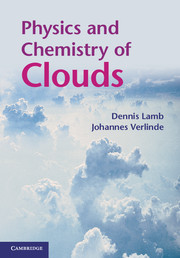Book contents
- Frontmatter
- Contents
- Preface
- Part I Background
- Part II Transformations
- Part III Cloud macrophysics
- Part IV Cloud microphysics
- Part V Cloud-scale and population effects
- 10 Evolution of supersaturation
- 11 Warm clouds
- 12 Cold clouds
- 13 Cloud chemistry
- 14 Cloud electrification
- Appendix A Cloud classification
- Appendix B Overview of thermodynamics
- Appendix C Boltzmann distribution
- References
- Index
13 - Cloud chemistry
from Part V - Cloud-scale and population effects
Published online by Cambridge University Press: 07 October 2011
- Frontmatter
- Contents
- Preface
- Part I Background
- Part II Transformations
- Part III Cloud macrophysics
- Part IV Cloud microphysics
- Part V Cloud-scale and population effects
- 10 Evolution of supersaturation
- 11 Warm clouds
- 12 Cold clouds
- 13 Cloud chemistry
- 14 Cloud electrification
- Appendix A Cloud classification
- Appendix B Overview of thermodynamics
- Appendix C Boltzmann distribution
- References
- Index
Summary
Overview
Clouds play important roles in the composition of the atmosphere and in the chemical quality of precipitation. Cloud particles form in the first place by condensation onto aerosol particles composed of diverse compounds. Then, they take up additional chemicals from the air, change their chemical properties, and eventually release modified compounds back into the air or transfer them to large, sedimenting particles. Clouds effectively cleanse the air through precipitation, which serves as the carrier of atmospheric chemicals to terrestrial and aquatic ecosystems. Clouds simultaneously depend on the chemicals in the air and influence the composition of the atmosphere through a variety of microchemical processes.
The term microchemistry in cloud physics parallels that of microphysics. Both disciplines deal with the particles making up clouds, but the emphasis in cloud microchemistry is on the chemicals contained in the particles, not on the particles themselves. Atmospheric trace chemicals influence cloud properties in important ways, and the cloud microphysics also determine the fates of atmospheric chemicals. Important goals of microchemical research include understanding source-receptor relationships, the chemical quality of precipitation, and the influence trace chemicals have on clouds and climate.
As soon as pollutants enter a cloud, they become intertwined with the cloud processes at both the macro- and microscales. The active dynamics of a large convective cloud, for instance, often serves to vent the planetary boundary layer, pulling pollutants into the free troposphere along with the moisture that serves as the fuel for cloud formation (see Fig. 13.1).
- Type
- Chapter
- Information
- Physics and Chemistry of Clouds , pp. 480 - 528Publisher: Cambridge University PressPrint publication year: 2011



